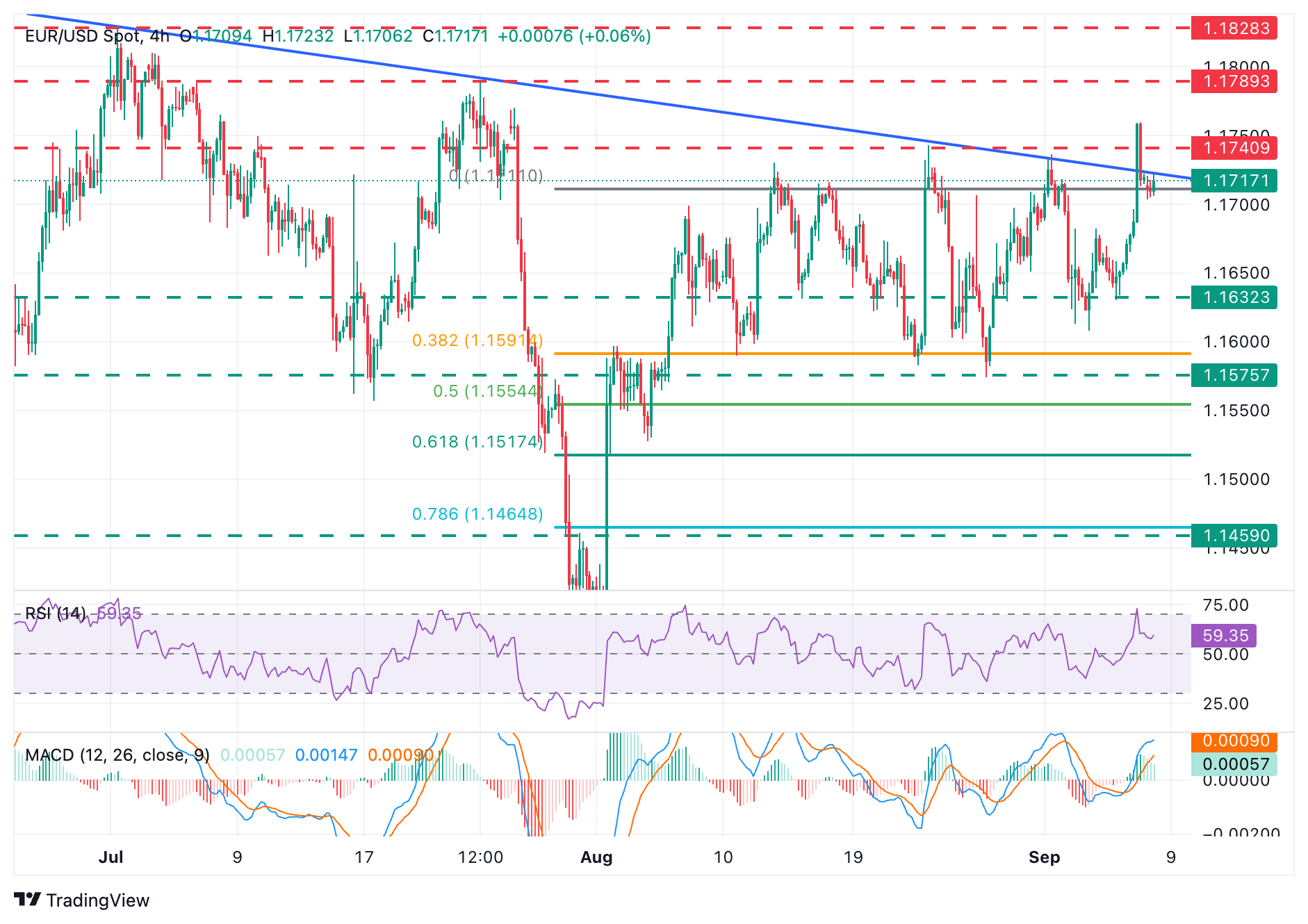Created
: 2025.09.08














![]() 2025.09.08 16:43
2025.09.08 16:43
The EUR/USD pair is ticking higher, trading near 1.1715 at the European session opening on Monday. The common currency is drawing support from a weak US Dollar after the poor US Nonfarm Payrolls (NFP) report seen on Friday, although a highly likely collapse of the French Government keeps Euro bulls in check.
NFP confirmed the deterioration of the US labour market, with its weakest growth since 2021 and a higher Unemployment Rate. The data practically confirmed market expectations of an interest rate cut at next week's Federal Reserve (Fed) meeting and brought the possibility of a 50 basis points cut back to the table. The US Dollar tumbled following the release.
The Euro, however, is seeing its own troubles on Monday, as France's Prime Minister Francoise Bayrou is facing a confidence vote, doomed to failure, later on the day. France's long-term yields are pulling back from last week's multi-year highs, but investors' concerns about political turmoil in the Euro area's second-largest economy pose a significant threat to the currency.
On the macroeconomic data front, German Industrial Production figures bounced up as expected, but the trade surplus narrowed beyond expectations. Later in the day, the Sentix Investor Confidence data will gather some attention. The highlight of the week, however, will be the European Central Bank's (ECB) monetary policy decision, due on Thursday.
The table below shows the percentage change of Euro (EUR) against listed major currencies today. Euro was the strongest against the British Pound.
| USD | EUR | GBP | JPY | CAD | AUD | NZD | CHF | |
|---|---|---|---|---|---|---|---|---|
| USD | -0.05% | 0.02% | -0.10% | -0.04% | -0.24% | -0.20% | -0.19% | |
| EUR | 0.05% | 0.06% | 0.02% | 0.03% | -0.18% | -0.11% | -0.14% | |
| GBP | -0.02% | -0.06% | -0.14% | -0.06% | -0.24% | -0.17% | -0.20% | |
| JPY | 0.10% | -0.02% | 0.14% | 0.00% | -0.15% | -0.24% | -0.05% | |
| CAD | 0.04% | -0.03% | 0.06% | -0.01% | -0.11% | -0.11% | -0.16% | |
| AUD | 0.24% | 0.18% | 0.24% | 0.15% | 0.11% | 0.07% | 0.04% | |
| NZD | 0.20% | 0.11% | 0.17% | 0.24% | 0.11% | -0.07% | -0.03% | |
| CHF | 0.19% | 0.14% | 0.20% | 0.05% | 0.16% | -0.04% | 0.03% |
The heat map shows percentage changes of major currencies against each other. The base currency is picked from the left column, while the quote currency is picked from the top row. For example, if you pick the Euro from the left column and move along the horizontal line to the US Dollar, the percentage change displayed in the box will represent EUR (base)/USD (quote).

EUR/USD is showing an improved technical picture. The 4-hour RSI is within bullish territory at 59, and so is the MACD, but the resistance area between 1.1720 and 1.1740 might be a tough nut to crack.
The pair is now testing the trendline resistance from July 1 highs at 1.1830. Above here, the 1.1740 area, which broadly encloses the highs of August 13 and 22, and September 1, is likely to challenge bulls ahead of Friday's 1.1560 high.
Immediate support is at the intraday low, right above the 1.1700 round number. Further down, the September 4 low, at the 1.1630 area, might cap downside attempts ahead of the zone between 1.1575 and 1.1590, which held bears on August 11, 22, and 27.
The Euro is the currency for the 19 European Union countries that belong to the Eurozone. It is the second most heavily traded currency in the world behind the US Dollar. In 2022, it accounted for 31% of all foreign exchange transactions, with an average daily turnover of over $2.2 trillion a day. EUR/USD is the most heavily traded currency pair in the world, accounting for an estimated 30% off all transactions, followed by EUR/JPY (4%), EUR/GBP (3%) and EUR/AUD (2%).
The European Central Bank (ECB) in Frankfurt, Germany, is the reserve bank for the Eurozone. The ECB sets interest rates and manages monetary policy. The ECB's primary mandate is to maintain price stability, which means either controlling inflation or stimulating growth. Its primary tool is the raising or lowering of interest rates. Relatively high interest rates - or the expectation of higher rates - will usually benefit the Euro and vice versa. The ECB Governing Council makes monetary policy decisions at meetings held eight times a year. Decisions are made by heads of the Eurozone national banks and six permanent members, including the President of the ECB, Christine Lagarde.
Eurozone inflation data, measured by the Harmonized Index of Consumer Prices (HICP), is an important econometric for the Euro. If inflation rises more than expected, especially if above the ECB's 2% target, it obliges the ECB to raise interest rates to bring it back under control. Relatively high interest rates compared to its counterparts will usually benefit the Euro, as it makes the region more attractive as a place for global investors to park their money.
Data releases gauge the health of the economy and can impact on the Euro. Indicators such as GDP, Manufacturing and Services PMIs, employment, and consumer sentiment surveys can all influence the direction of the single currency. A strong economy is good for the Euro. Not only does it attract more foreign investment but it may encourage the ECB to put up interest rates, which will directly strengthen the Euro. Otherwise, if economic data is weak, the Euro is likely to fall. Economic data for the four largest economies in the euro area (Germany, France, Italy and Spain) are especially significant, as they account for 75% of the Eurozone's economy.
Another significant data release for the Euro is the Trade Balance. This indicator measures the difference between what a country earns from its exports and what it spends on imports over a given period. If a country produces highly sought after exports then its currency will gain in value purely from the extra demand created from foreign buyers seeking to purchase these goods. Therefore, a positive net Trade Balance strengthens a currency and vice versa for a negative balance.
![]()
Created
: 2025.09.08
![]()
Last updated
: 2025.09.08

FXStreet is a forex information website, delivering market analysis and news articles 24/7.
It features a number of articles contributed by well-known analysts, in addition to the ones by its editorial team.
Founded in 2000 by Francesc Riverola, a Spanish economist, it has grown to become a world-renowned information website.
We hope you find this article useful. Any comments or suggestions will be greatly appreciated.
We are also looking for writers with extensive experience in forex and crypto to join us.
please contact us at [email protected].
Disclaimer:
All information and content provided on this website is provided for informational purposes only and is not intended to solicit any investment. Although all efforts are made in order to ensure that the information is correct, no guarantee is provided for the accuracy of any content on this website. Any decision made shall be the responsibility of the investor and Myforex does not take any responsibility whatsoever regarding the use of any information provided herein.
The content provided on this website belongs to Myforex and, where stated, the relevant licensors. All rights are reserved by Myforex and the relevant licensors, and no content of this website, whether in full or in part, shall be copied or displayed elsewhere without the explicit written permission of the relevant copyright holder. If you wish to use any part of the content provided on this website, please ensure that you contact Myforex.
Myforex uses cookies to improve the convenience and functionality of this website. This website may include cookies not only by us but also by third parties (advertisers, log analysts, etc.) for the purpose of tracking the activities of users. Cookie policy